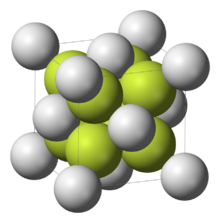Chemistry:Barium fluoride

| |

| |
| Identifiers | |
|---|---|
3D model (JSmol)
|
|
| ChemSpider | |
PubChem CID
|
|
| RTECS number |
|
| UNII | |
| |
| |
| Properties | |
| BaF 2 | |
| Molar mass | 175.324 g/mol[1] |
| Appearance | white cubic crystals[1] |
| Density | 4.893 g/cm3[1] |
| Melting point | 1,368 °C (2,494 °F; 1,641 K)[1] |
| Boiling point | 2,260 °C (4,100 °F; 2,530 K)[1] |
| 1.58 g/L (10 °C) 1.61 g/L (25 °C)[2] | |
Solubility product (Ksp)
|
1.84·10−7[3] |
| Solubility | soluble in methanol, ethanol |
| −51·10−6 cm3/mol[4] | |
| Thermal conductivity | 10.9 W/(m·K)[5] |
Refractive index (nD)
|
|
| Structure[7] | |
| Fluorite (cubic), cF12 | |
| Fm3m, No. 225 | |
a = 0.62 nm
| |
Formula units (Z)
|
4 |
| Thermochemistry[8] | |
Heat capacity (C)
|
71.2 J/(mol·K) |
Std molar
entropy (S |
96.4 J/(mol·K) |
Std enthalpy of
formation (ΔfH⦵298) |
−1207.1 kJ/mol |
Gibbs free energy (ΔfG˚)
|
−1156.8 kJ/mol |
| Hazards | |
| Main hazards | Toxic |
| Safety data sheet | PubChem |
| GHS pictograms | 
|
| Flash point | Non-flammable |
| Lethal dose or concentration (LD, LC): | |
LD50 (median dose)
|
250 mg/kg, oral (rat) |
| Related compounds | |
Other anions
|
|
Other cations
|
|
Except where otherwise noted, data are given for materials in their standard state (at 25 °C [77 °F], 100 kPa). | |
| Infobox references | |
Barium fluoride is an inorganic compound with the formula BaF
2. It is a colorless solid that occurs in nature as the rare mineral frankdicksonite.[9] Under standard conditions it adopts the fluorite structure and at high pressure the PbCl
2 structure.[10] Like CaF
2, it is resilient to and insoluble in water.
Above ca. 500 °C, BaF
2 is corroded by moisture, but in dry environments it can be used up to 800 °C. Prolonged exposure to moisture degrades transmission in the vacuum UV range. It is less resistant to water than calcium fluoride, but it is the most resistant of all the optical fluorides to high-energy radiation, though its far ultraviolet transmittance is lower than that of the other fluorides. It is quite hard, very sensitive to thermal shock and fractures quite easily.
Optical properties
Barium fluoride is transparent from the ultraviolet to the infrared, from 150 to 200 nm to 11–11.5 µm. It is used in windows for infrared spectroscopy, in particular in the field of fuel oil analysis. Its transmittance at 200 nm is relatively low (0.60), but at 500 nm it goes up to 0.96–0.97 and stays at that level until 9 µm, then it starts falling off (0.85 for 10 µm and 0.42 for 12 µm). The refractive index is about 1.46 from 700 nm to 5 µm.[11]
Barium fluoride is also a common, very fast (one of the fastest) scintillators for the detection of X-rays, gamma rays or other high energy particles. One of its applications is the detection of 511 keV gamma photons in positron emission tomography. It responds also to alpha and beta particles, but, unlike most scintillators, it does not emit ultraviolet light.[12] It can be also used for detection of high-energy (10–150 MeV) neutrons, using pulse shape discrimination techniques to separate them from simultaneously occurring gamma photons.
Barium fluoride is used as a preopacifying agent and in enamel and glazing frits production. Its other use is in the production of welding agents (an additive to some fluxes, a component of coatings for welding rods and in welding powders). It is also used in metallurgy, as a molten bath for refining aluminium.
Gas phase structure
In the vapor phase the BaF
2 molecule is non-linear with an F-Ba-F angle of approximately 108°.[13] Its nonlinearity violates VSEPR theory. Ab initio calculations indicate that contributions from d orbitals in the shell below the valence shell are responsible.[14] Another proposal is that polarisation of the electron core of the barium atom creates an approximately tetrahedral distribution of charge that interacts with the Ba-F bonds.[15]
References
- ↑ 1.0 1.1 1.2 1.3 1.4 Haynes, p. 4.49
- ↑ Haynes, p. 5.167
- ↑ John Rumble (June 18, 2018) (in English). CRC Handbook of Chemistry and Physics (99th ed.). CRC Press. pp. 4–47. ISBN 978-1138561632.
- ↑ Haynes, p. 4.126
- ↑ Haynes, p. 12.222
- ↑ Haynes, p. 10.248
- ↑ Hohnke, D. K.; Kaiser, S. W. (1974). "Epitaxial PbSe and Pb1−xSxSe: Growth and electrical properties". Journal of Applied Physics 45 (2): 892–897. doi:10.1063/1.1663334. Bibcode: 1974JAP....45..892H.
- ↑ Haynes, p. 5.5
- ↑ Radtke A.S., Brown G.E. (1974). "Frankdicksonite, BaF2, a New Mineral from Nevada". American Mineralogist 59: 885–888. http://www.minsocam.org/ammin/AM59/AM59_885.pdf.
- ↑ Wells, A.F. (1984). Structural inorganic chemistry −5th Edition. Oxford: Clarendon Press. ISBN 0-19-855370-6.
- ↑ "Crystran Ltd. Optical Component Materials". http://www.crystran.co.uk/barium-fluoride-baf2.htm.
- ↑ Laval, M; Moszyński, M.; Allemand, R.; Cormoreche, E.; Guinet, P.; Odru, R.; Vacher, J. (1983). "Barium fluoride – Inorganic scintillator for subnanosecond timing". Nuclear Instruments and Methods in Physics Research 206 (1–2): 169–176. doi:10.1016/0167-5087(83)91254-1. Bibcode: 1983NIMPR.206..169L.
- ↑ Greenwood, Norman N.; Earnshaw, Alan (1997). Chemistry of the Elements (2nd ed.). Butterworth-Heinemann. ISBN 978-0-08-037941-8.
- ↑ Seijo, Luis; Barandiarán, Zoila; Huzinaga, Sigeru (1991). "Ab initio model potential study of the equilibrium geometry of alkaline earth dihalides: MX2 (M=Mg, Ca, Sr, Ba; X=F, Cl, Br, I)". The Journal of Chemical Physics 94 (5): 3762. doi:10.1063/1.459748. Bibcode: 1991JChPh..94.3762S. https://repositorio.uam.es/bitstream/10486/7315/1/41581_jchemphysseijo_91_jcp_94_3762.pdf.
- ↑ Bytheway, Ian; Gillespie, Ronald J.; Tang, Ting-Hua; Bader, Richard F. W. (1995). "Core Distortions and Geometries of the Difluorides and Dihydrides of Ca, Sr, and Ba". Inorganic Chemistry 34 (9): 2407. doi:10.1021/ic00113a023.
Cited sources
- Haynes, William M., ed (2016). CRC Handbook of Chemistry and Physics (97th ed.). CRC Press. p. 4.49. ISBN 9781498754293.
External links
 |

